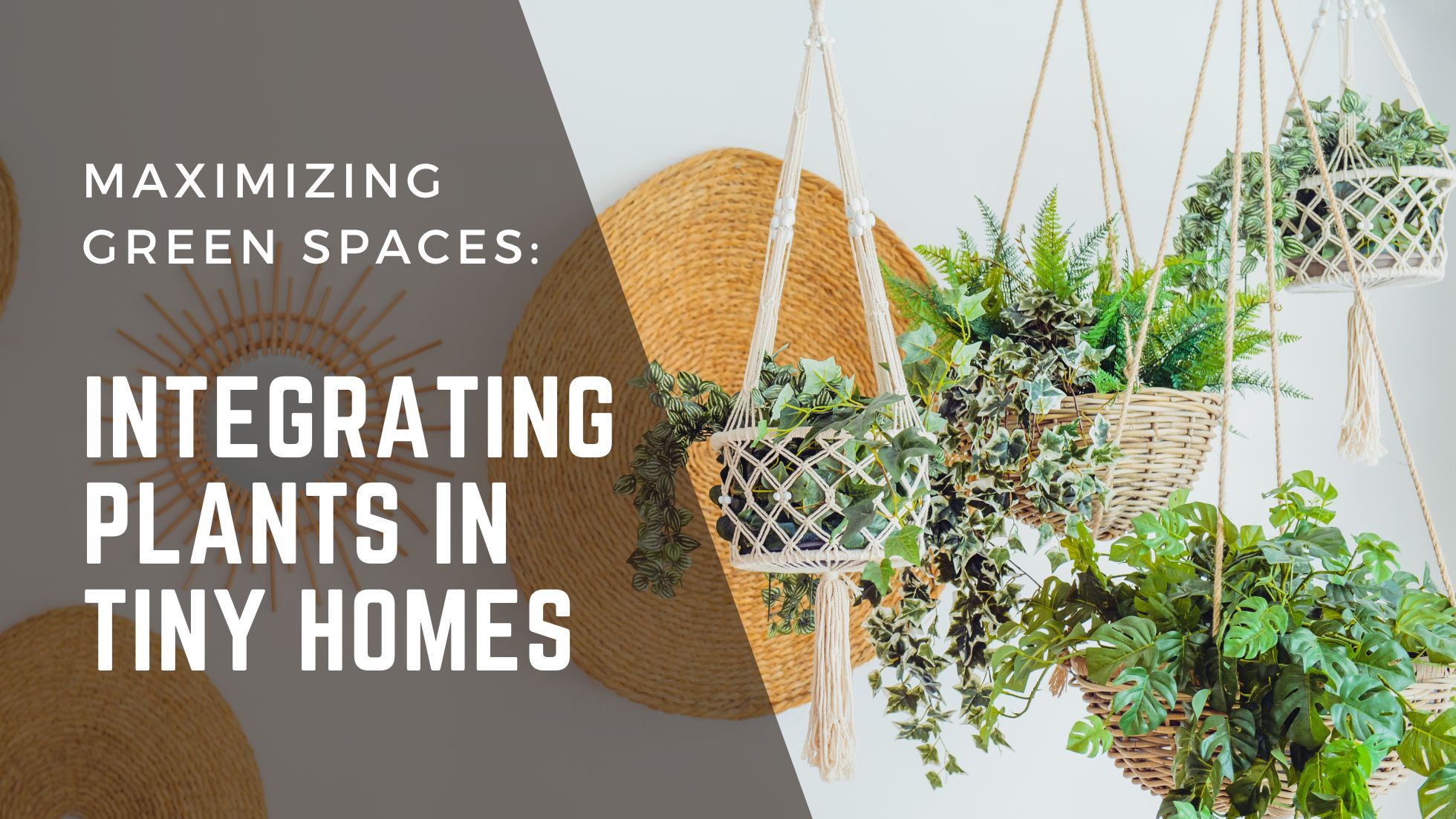
Living in a tiny home often means finding creative ways to make the most of limited space. One of the most effective and rewarding ways to enhance the ambiance and air quality of a tiny home is by integrating plants. Plants bring a touch of nature indoors and offer numerous health benefits, including improved air quality and reduced stress levels. In this blog, we will explore how to effectively use plants to maximize green spaces in tiny homes, with a focus on vertical gardens, indoor herb planters, and other space-efficient greenery solutions.
The Benefits of Integrating Plants in Tiny Homes
- Improved Air Quality: Plants naturally filter toxins from the air, improving indoor air quality. They absorb carbon dioxide and release oxygen, making the air fresher and healthier to breathe.
- Enhanced Ambiance: Greenery adds a calming and aesthetically pleasing element to any space. The presence of plants can make a tiny home feel more inviting and tranquil.
- Mental Health Benefits: Studies have shown that being around plants can reduce stress, boost mood, and improve concentration.
- Space Optimization: Plants can be used creatively to optimize space, acting as natural dividers, enhancing privacy, and adding layers of texture to the decor.
Now, let’s explore how to effectively integrate plants into your tiny home.
Vertical Gardens
One of the best ways to incorporate greenery into a tiny home is by utilizing vertical gardens. Vertical gardens, also known as living walls, allow you to grow plants upward instead of outward, saving precious floor space.
Tips for Creating a Vertical Garden
- Choose the Right Wall: Select a wall that receives adequate light. South-facing walls are typically the best for sunlight exposure. If natural light is limited, consider using grow lights.
- Select Suitable Plants: Choose plants that thrive in vertical settings and have similar light and water requirements.
- Install a Vertical Planter: Use wall-mounted planters, hanging pots, or pocket planters to create your vertical garden. Ensure the system you choose has proper drainage to prevent water damage to your walls.
- Maintenance: Regularly check your plants for water, trim dead leaves, and ensure they are receiving enough light. A self-watering system can be a great addition to reduce maintenance time.
Indoor Herb Planters
Having fresh herbs at your fingertips can enhance your cooking and provide a fresh, fragrant atmosphere in your tiny home.
Tips for Indoor Herb Planters
- Select the Right Herbs: Choose herbs that you frequently use in cooking and that are easy to grow indoors, such as basil, parsley, mint, and rosemary.
- Use Space-Efficient Planters: Opt for tiered herb planters, window boxes, or small pots that can be placed on windowsills or kitchen counters. Magnetic planters that stick to your refrigerator can also save space.
- Ensure Proper Light: Most herbs need plenty of sunlight. Place your herb planters in a sunny spot, such as a kitchen window. If sunlight is limited, use LED grow lights to supplement.
- Regular Harvesting: Trim your herbs regularly to promote new growth. This practice also ensures you have a constant supply of fresh herbs for your kitchen.
Space-Efficient Greenery
Beyond vertical gardens and herb planters, there are numerous other creative ways to integrate plants into your tiny home without sacrificing space.
Hanging Planters
Hanging planters are an excellent solution for adding greenery without using floor or counter space. You can hang them from the ceiling, above windows, or even in the corners of rooms.
Floating Shelves
Install floating shelves on your walls to display small potted plants. This not only adds greenery but also creates an interesting visual element. Combine plants with other decorative items for a cohesive look.
Terrariums
Terrariums are miniature gardens that can be placed on tables, shelves, or windowsills. They are low-maintenance and can house a variety of plants, from succulents to air plants.
Plant Stands
If you have a bit of floor space to spare, consider using plant stands. They come in various sizes and designs, allowing you to elevate your plants and create a multi-tiered green space.
Window Gardens
Utilize your windowsills by creating a window garden. Line up small pots or use suction-cup planters that stick to the glass. This is a great way to grow flowers, herbs, or small leafy plants.
Choosing the Right Plants
Here are some plants that are well-suited for small spaces and have air-purifying qualities:
Air-Purifying Plants
- Spider Plant (Chlorophytum comosum)
- Light: Indirect sunlight
- Care: Easy to care for; water when the soil is dry
- Benefits: Excellent air purifier, removing toxins
- Snake Plant (Sansevieria trifasciata)
- Light: Low to bright indirect light
- Care: Very low maintenance; water every few weeks
- Benefits: Filters toxins and releases oxygen at night, improving indoor air quality
- Peace Lily (Spathiphyllum)
- Light: Low to moderate indirect light
- Care: Keep soil moist but not waterlogged
- Benefits: Removes airborne toxins
Compact and Space-Efficient Plants
- Succulents (Various species)
- Light: Bright, direct light
- Care: Minimal water, allowing soil to dry out completely between waterings
- Benefits: Small and easy to place in various containers, add a touch of greenery with minimal effort
- ZZ Plant (Zamioculcas zamiifolia)
- Light: Low to bright indirect light
- Care: Drought-tolerant; water infrequently
- Benefits: Hardy plant that thrives with little care, perfect for low-light areas
- Pothos (Epipremnum aureum)
- Light: Low to moderate indirect light
- Care: Water when the soil is dry
- Benefits: Easy to grow, excellent for hanging planters or trailing from shelves, helps purify the air
Herbs for Indoor Gardens
- Basil (Ocimum basilicum)
- Light: Full sun (6-8 hours of sunlight per day)
- Care: Keep the soil moist but not waterlogged
- Benefits: Fresh herb for cooking, aromatic, easy to grow indoors with sufficient light
- Mint (Mentha)
- Light: Bright, indirect light
- Care: Keep soil consistently moist
- Benefits: Versatile culinary herb, pleasant fragrance, can thrive in containers
- Rosemary (Rosmarinus officinalis)
- Light: Full sun
- Care: Allow soil to dry out between waterings
- Benefits: Aromatic herb, enhances dishes, can be pruned to maintain a compact size
Vertical Garden-Friendly Plants
- English Ivy (Hedera helix)
- Light: Bright, indirect light
- Care: Keep soil moist, but not waterlogged
- Benefits: Great for vertical gardens, air-purifying properties
- Fern (Various species, like Boston Fern)
- Light: Indirect light, avoid direct sunlight
- Care: Keep soil consistently moist, high humidity
- Benefits: Adds lush greenery, ideal for vertical planters or hanging baskets
- Philodendron (Various species)
- Light: Low to bright indirect light
- Care: Water when the top inch of soil is dry
- Benefits: Excellent for trailing or climbing, helps purify the air
Low-Maintenance Options
- Aloe Vera (Aloe barbadensis miller)
- Light: Bright, indirect light
- Care: Water deeply but infrequently, allowing the soil to dry out between waterings
- Benefits: Medicinal properties, low maintenance, suitable for small spaces
- Cactus (Various species)
- Light: Bright, direct light
- Care: Minimal watering, well-draining soil
- Benefits: Requires little care, unique shapes and sizes add visual interest
- Chinese Evergreen (Aglaonema)
- Light: Low to moderate light
- Care: Water when the top inch of soil is dry
- Benefits: Hardy and adaptable, good for low-light conditions
Integrating plants into a tiny home is a wonderful way to enhance both the aesthetics and the quality of your living space. By using vertical gardens, indoor herb planters, and other space-efficient greenery solutions, you can create a lush, vibrant environment without compromising on space. Whether you’re an experienced gardener or just starting, the benefits of adding plants to your tiny home are substantial.
Start small, experiment with different plants and arrangements, and watch as your tiny home transforms into a green oasis.
